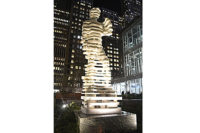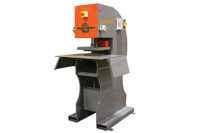Using Computer Numerically Controlled technology, machines such as the Laser Master from Cam Tech produce high-resolution images on virtually any stone. And given the intricacy of the work involved, these machines work at a surprisingly quick rate of 25 to 90 minutes per square foot.
The following is a look at three firms that have incorporated laser etching as
a key component of their business:
Picture This on Granite
Stanstead, Quebec, Canada
Picture This on Granite uses the Cam Tech Laser Master for a range of applications - from residential furnishings to memorials and portraits. "We are getting into kitchen backsplashes, and we're also in the monumental [sector]," explained Bonnie Goodsell of Picture This on Granite. "We're doing coasters, corporate items, signage, personalized portraits and feature tiles. There are a lot of different markets that we can get into."The company is doing custom work in laser etching as well as standardized pieces. "We are building [a library of] standard designs right now, such as flower baskets, fruit bowls, ornamental accents and florishes. But if people want to send us e-mails with digital images of portraits and such, or if they send us a photo of a cottage or something that they would want to see, we can do it," she said. "One customer we have owns a country home and city home. They had images of both and they are reversed in each home, [with the image of the country home displayed in the kitchen of the city home and vice versa.]"
Once the images are received, Liz Fisher, the company's industrial graphic designer, uses specialized software to manipulate the images as needed prior to fabrication. "We received three to four Christmas items in a .jpg format over the Internet, and we manipulated them for 30 to 60 minutes, depending on what needed to be done," Goodsell said. In addition to scanning in a photo, the software can add borders and other visual effects to the edges of the photos.
The company has worked on different types of granite and slate, although black granite has worked the best for its line of work. "Lettering of poems and similar work comes out very well," Goodsell said, adding that it's important to start with an image that is of high resolution. "When you have to blow a photo up, you can lose clarity."
The machine can process a standard 12- x 12-inch tile in approximately 90 minutes, and monuments can take between one and six hours to complete, depending on the size and complexity of the piece.
Goodsell explained that the machine was relatively simple to learn. "The key steps are cleaning up or manipulating the photo using CorelDraw and adjusting the contrast and brightness using a program called Photopaint. From there, you adjust the intensity of the laser. We run 12% to 18%, depending on the granite and the image. Essentially, it vaporizes the polish off. It's not like sandblasting because it doesn't carve into the stone. If you ran your hand across it, it would feel smooth." This also eases maintenance of the completed work, particularly for residential kitchen, bathroom and fireplace applications.
As her business grows, Goodsell anticipates that it will be a simple task to educate new workers on the use of the machine. "You don't need a lot of computer knowledge," she said. "Once you have the basic programs down, you're ready to go."
Laser Quarry Inc.
Fort Pierce, FL
Laser Quarry Inc. uses two different laser etching machines for its work, including the Laser Master from Cam Tech as well as a second smaller machine from Vytek. The company works on a broad range of materials and objects - ranging from small coasters to larger murals.The etching process begins with high-quality images - pictures, designs, logos or text - which either scanned or downloaded into a personal computer. These digital images are then enhanced and properly sized to the proper specifications. Once the digital image is ready, the data is then sent to the laser graphics system, which controls the movement of the machine's laser.
According to Jos?. Ubilla, president of Laser Quarry, there were two steps in learning how to laser etch natural stone. "First, we had to learn the machine. Then, we needed to learn how the different stones would work with the system," he said. "We had to learn what intensity to use for each particular stone, since each stone will react differently." According to Ubilla, a 12- x 12- inch tile can be processed in 25 minutes.
The company works on a broad range of materials, including dark granites and marbles. Because of the unique abilities of the laser etching machine, the company is also able to produce personalized awards. In a recent example, the company produced awards for the Treasure Coast Building Association in Florida, and all of the stone plaques included an etched image of the winning project.
The company is currently looking to establish a network of specifiers, dealers and builders. According to Ubilla, marketing is a large focus for the company, which has developed slogans such as "Etching the World in Real Stone." Laser Quarry also exhibits at shows such as Surfaces, Coverings, StonExpo, the Architectural Digest Show in New York and the Miami Boat Show. To give potential customers a hands-on understanding of the process, the company actually brings the Vytek machine to the trade shows to better demonstrate its capabilities.
Laser Spec, Inc.
Calgary, Alberta, Canada
Laser Spec, Inc. of Calgary, Alberta, Canada, uses a laser etching machine to create large-scale designs in natural stone. "We work on slabs as well as tiles," explained Grant Sobush of Laser Spec. "Often, we'll use 12- x 12-inch tiles and create images that are 12 x 12 feet or 9 x 9 feet." These images, he explained, are often used to adorn the interior walls of a building. "We have tried to focus on [creating] larger images. Because it's a new industry, we're going about it very openly, and we're looking to do a lot of different things."Although the company had been working with a variety of Computer Numerically Controlled equipment over the past 13 years, the laser-etching machine marked a dramatically new direction for the company, Sobush said. "It's definitely not replacing anything we did." As such, Laser Spec has been concentrating a good deal of effort on informing its customer base of its new capabilities. "We're using our existing sources, and we're pounding on a lot of doors and letting people know that this is something that we can do," he said. "It's new, but at the same time, people don't always like to buy into something new. We have it [established] as another division of our company, and that excites people as well."
According to Sobush, the machine's operation is similar to that of a laser printer, except that it can work on any substrate. "Typically, you're working from a scan. The better the image is before you start, the better it's going to turn out in real life," he explained. "The scan is manipulated in your design package, and you use Corel Photoshop to work on brightness and 'noise removal.' "
The company has worked in a broad range of materials, including varieties of granite, slate, marble and jade. "There seems to be a difference, depending on the quality of the rock," Sobush said, adding that certain stones are more conducive to the process than others. "Any stone that has a high density works better for etching."
Additionally, the veining of certain marbles reads through the etching. "It might not be advisable if you were etching a face or something like that," Sobush said. "But neoclassical designs would work well with the veining coming through, because that accentuates [the motif]."
Laser Spec has used the machine to create a wide variety of images. "You really can do any kind of design imaginable," he said. "People like for you to give them some input. We've done some nature scenes, and images of animals. We did a 9- x 9-foot mural of two zebras. We've done [images of] trains and hot rod cars. Typically, we can begin any photograph, and just scan it in."
The machine's work area can accommodate 36 square feet at a time. "Once [a project is] programmed in and loaded, there's not much operator intervention," he said, adding that it takes 60 to 90 minutes per square foot to execute an image, depending on the resolution. "A higher resolution takes a longer time from start to finish. If it will never be seen any closer than 30 feet away, then you may not need as high a resolution. But if people are walking up to it, you'll want to go with a high resolution."
Despite the uniqueness of the laser-etching process, Sobush said it was easy to learn the technology. "It's been a joy. Out of all the equipment we've ever owned, this is probably the most user-friendly piece of equipment we've ever purchased," he said, adding that all of the workers in his shop can operate the machine. "There are two different levels. Everybody learns it to a certain degree. Anyone in the building can walk up to the machine and start and etching, although not everyone can program an etching."




